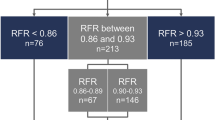Abstract
The diastolic pressure ratio (dPR) and resting full-cycle ratio (RFR) are considered to be almost identical to the instantaneous wave-free ratio (iFR) in the retrospective analysis of pooled data. The aim of this study was to investigate the direct comparison of iFR and these new resting indexes in real world practice. Two pressure wires were inserted and placed in the distal part of the same coronary artery. The measurement of the iFR and the other resting indexes was performed simultaneously. A total of 54 lesions from 23 patients were subject to physiological study. In 49 lesions, iFR and other resting indexes were also measured in hyperemic conditions. The general correlation between iFR and other resting indexes was excellent in both resting and hyperemic conditions (r2 = 0.99; mean difference − 0.001 ± 0.021; p < 0.001; and r2 = 0.99; mean difference − 0.012 ± 0.025; p < 0.001, respectively). This correlation was maintained in various subgroup analyses. A diagnostic change between iFR and other resting indexes occurred in three cases (3%) when a fixed cut-off point (≤ 0.89) was applied. There was no diagnostic change when a hybrid zone (0.86 ≤ iFR ≤ 0.93) was considered. The new resting indexes and iFR showed very high correlation in real world practice. A diagnostic change only occurred in three cases (3%) when a fixed cut-off point (≤ 0.89) was applied.



Similar content being viewed by others
References
Davies JE, Sen S, Dehbi HM, Al-Lamee R, Petraco R, Nijjer SS, et al. Use of the instantaneous wave-free ratio or fractional flow reserve in PCI. N Engl J Med. 2017;376:1824–34.
Escaned J, Collet C, Ryan N, De Maria GL, Walsh S, Sabate M, et al. Clinical outcomes of state-of-the-art percutaneous coronary revascularization in patients with de novo three vessel disease: 1-year results of the SYNTAX II study. Eur Heart J. 2017;38:3124–34.
Sousa-Uva M, Neumann FJ, Ahlsson A, Alfonso F, Banning AP, Benedetto U, et al. 2018 ESC/EACTS Guidelines on myocardial revascularization. Eur J Cardiothorac Surg. 2019;55(1):4–90.
Lee JM, Choi KH, Park J, Hwang D, Rhee TM, Kim J, et al. Physiological and clinical assessment of resting physiological indexes. Circulation. 2019;139:889–900.
Svanerud J, Ahn JM, Jeremias A, Veer M, Gore A, Maehara A, et al. Validation of a novel non-hyperaemic index of coronary artery stenosis severity: the Resting Full-cycle Ratio (VALIDATE RFR) study. EuroIntervention. 2018;14(7):806–14.
Beygui F, Lemaitre A, Bignon M, Wain-Hobson J, Briet C, Ardouin P, et al. A head-to-head comparison of three coronary fractional flow reserve measurement technologies: the fractional flow reserve-device study. Catheter Cardiovasc Interv. 2019. https://doi.org/10.1002/ccd.28433.
Jang HJ, Koo BK, Lee HS, Park JB, Kim JH, Seo MK, et al. Safety and efficacy of a novel hyperaemic agent, intracoronary nicorandil, for invasive physiological assessments in the cardiac catheterization laboratory. Eur Heart J. 2013;34:2055–62.
Oi M, Toyofuku M, Matsumura Y, Motohashi Y, Takahashi K, Kawase Y, et al. Utility of nicorandil for the measurement of coronary fractional flow reserve. Cardiovasc Interv Ther. 2014;29:24–30.
Kato D, Takashima H, Waseda K, Kurita A, Kuroda Y, Kosaka T, et al. Feasibility and safety of intracoronary nicorandil infusion as a novel hyperemic agent for fractional flow reserve measurements. Heart Vessels. 2015;30:477–83.
Stables RH, Elguindy M, Kemp I, Nicholas Z, Mars C, Mullen L, et al. A randomised controlled trial to compare two coronary pressure wires using simultaneous measurements in human coronary arteries: the COMET trial. EuroIntervention. 2019;14:e1578–e15841584.
Acknowledgements
Special thanks go to Shunsuke Imai for his work in collecting and analyzing the study-related data.
Funding
This research received no grant from any funding agency in the public, commercial or not-for-profit sectors.
Author information
Authors and Affiliations
Corresponding author
Ethics declarations
Conflict of interest
The Authors declares that there is no conflict of interest.
Additional information
Publisher's Note
Springer Nature remains neutral with regard to jurisdictional claims in published maps and institutional affiliations.
Rights and permissions
About this article
Cite this article
Kawase, Y., Omori, H., Tanigaki, T. et al. In vivo validation of resting full-cycle ratio and diastolic pressure ratio: simultaneous measurement with instantaneous wave-free ratio. Cardiovasc Interv and Ther 36, 74–80 (2021). https://doi.org/10.1007/s12928-020-00648-4
Received:
Accepted:
Published:
Issue Date:
DOI: https://doi.org/10.1007/s12928-020-00648-4




